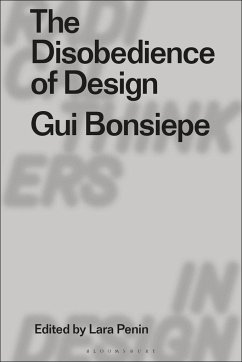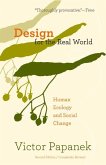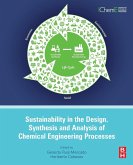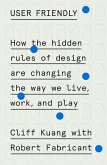Gui Bonsiepe (Independent Designer and Brazil Consultant)GUI Bonsiepe
The Disobedience of Design
GUI Bonsiepe
Herausgeber: Penin, Lara; Dilnot, Clive; Staszowski, Eduardo
Gui Bonsiepe (Independent Designer and Brazil Consultant)GUI Bonsiepe
The Disobedience of Design
GUI Bonsiepe
Herausgeber: Penin, Lara; Dilnot, Clive; Staszowski, Eduardo
- Broschiertes Buch
- Merkliste
- Auf die Merkliste
- Bewerten Bewerten
- Teilen
- Produkt teilen
- Produkterinnerung
- Produkterinnerung
Provides for the first time in English a curated selection of the writings of the design thinker Gui Bonsiepe, representing his writings on the Ulm design school, on the relations of â coreâ and â peripheryâ and design as a tool for social and political change.
Andere Kunden interessierten sich auch für
![The Disobedience of Design The Disobedience of Design]() Gui Bonsiepe (Independent Designer and Brazil Consultant)The Disobedience of Design97,99 €
Gui Bonsiepe (Independent Designer and Brazil Consultant)The Disobedience of Design97,99 €![Architecture and the Public World Architecture and the Public World]() Kenneth Frampton (USA Columbia University)Architecture and the Public World36,99 €
Kenneth Frampton (USA Columbia University)Architecture and the Public World36,99 €![Design for the Real World Design for the Real World]() Victor PapanekDesign for the Real World19,99 €
Victor PapanekDesign for the Real World19,99 €![Design Noir Design Noir]() Anthony Dunne (Dunne & UK Raby)Design Noir41,99 €
Anthony Dunne (Dunne & UK Raby)Design Noir41,99 €![The Hardware Hacker The Hardware Hacker]() Andrew Bunnie HuangThe Hardware Hacker24,99 €
Andrew Bunnie HuangThe Hardware Hacker24,99 €![Sustainability in the Design, Synthesis and Analysis of Chemical Engineering Processes Sustainability in the Design, Synthesis and Analysis of Chemical Engineering Processes]() Gerardo Ruiz MercadoSustainability in the Design, Synthesis and Analysis of Chemical Engineering Processes101,99 €
Gerardo Ruiz MercadoSustainability in the Design, Synthesis and Analysis of Chemical Engineering Processes101,99 €![User Friendly User Friendly]() Cliff KuangUser Friendly35,99 €
Cliff KuangUser Friendly35,99 €-
-
-
Provides for the first time in English a curated selection of the writings of the design thinker Gui Bonsiepe, representing his writings on the Ulm design school, on the relations of â coreâ and â peripheryâ and design as a tool for social and political change.
Produktdetails
- Produktdetails
- Radical Thinkers in Design
- Verlag: Bloomsbury Publishing PLC
- Seitenzahl: 480
- Erscheinungstermin: 7. April 2022
- Englisch
- Abmessung: 231mm x 154mm x 20mm
- Gewicht: 800g
- ISBN-13: 9781350162440
- ISBN-10: 1350162442
- Artikelnr.: 62348691
- Herstellerkennzeichnung
- Libri GmbH
- Europaallee 1
- 36244 Bad Hersfeld
- gpsr@libri.de
- Radical Thinkers in Design
- Verlag: Bloomsbury Publishing PLC
- Seitenzahl: 480
- Erscheinungstermin: 7. April 2022
- Englisch
- Abmessung: 231mm x 154mm x 20mm
- Gewicht: 800g
- ISBN-13: 9781350162440
- ISBN-10: 1350162442
- Artikelnr.: 62348691
- Herstellerkennzeichnung
- Libri GmbH
- Europaallee 1
- 36244 Bad Hersfeld
- gpsr@libri.de
Gui Bonsiepe
Introduction by Lara Penin
Notes on the Making of the Book
Recognition and Acknowledgements by Gui Bonsiepe
Editorial Acknowledgements
Part 1: Thinking Designing
Introduction to Part 1 by Frederico Duarte
(a) Essays on ulm
1.1 The Cartography of Modernity
1.2 Science and Design
1.3 The Relevance of the Ulm School of Design today
1.4 The Invisible Aspects of the HfG Ulm
(b) Theory and Practice
1.5 The Discomfort of Design Theory
1.6 Arabesques of Rationality: Or the Splendor and Boredom of Design
Methodology
1.7 The Uneasy Relationship of Design and Design Research
(c) Design, Politics, Ethics
1.8 Design, Nomadism and Politics: Interview with Alejandro Lazo Margain
1.9 Design and Democracy
1.10 Some Virtues of Design
Part II: Design in the "Periphery"
Introduction to Part II by Ethel Leon
(a) From Europe to South America
2.1 Peripheral Vision & Design Empowerment: Interview with James Fathers
2.2 Industrial Design in Chile 1971-1973: Interview with Hugo Palmarola
2.3 The Ulm Model in the Periphery
2.4 Industrialization Without Design
(b) Design in the "Periphery"
2.5 History of Design in Latin America
2.6 Aspects of Design in the Periphery
2.7 Between Favela Chic and Autonomy: Design in Latin America
(c) The Question of Difference
2.8 Between Marasmus and Hope
2.9 The Environment in the North-South Conflict
2.10 Identity and Counter-Identity of Design
Part III: Design, Visuality, Cognition
Introduction to Part III by Hugh Dubberly
(a) Design and Language
3.1 Through Language to Design
3.2 Design: from Material to Digital and Back
3.3 Design as Tool for Cognitive Metabolism: From Knowledge Production to
Knowledge Presentation
(b) Design/ Visuality/ Theory
3.4 Visual/Verbal Rhetoric
3.5 The Interface Design of Computer Programs
3.6 Designing Information
3.7 Visuality Discursivity, or Design: The Blind spot of Theory, Theory:
the Blind spot of Design
(c) Design and Crisis
3.8 Design and Crisis
3.9 Convergences / Divergences - Hannes Meyer and the HfG Ulm
3.10 The Disobedience of Design
Part IV: Design and Development / Projects
Introduction to Part IV by Constantin Boym
(a) Design Policy/Design and Development
4.1 Development Through Design, a Report for UNIDO, 1973
4.2 Design and Development: The Debate with Victor Papanek
a. Gui Bonsiepe: Review of Design for the Real World by Victor Papanek
b. Victor Papanek: Reply to Bonsiepe's Review
4.3 Design and Development 40 Years Later: Interview with Gabriel
Patrocínio and José Mauro Nunes
(b) Gui Bonsiepe: Selected Projects in Latin America
4.4 Inexpensive Record Player, Chile, 1972
4.5 Nutrition project: Spoon for Powdered Milk, Chile 1973
4.6 Agriculture project, Chopper, Chile, 1973
4.7 Consumer product: Air-conditioning, Argentina, 1980
4.8 Two projects for Local Industry in Brazil, 1984-86
4.9 Health Care Project: Needle for Blood Sampling, Brazil, 1986
(c) Case Study of Project Cybersyn, Chile
4.10 (a) Opsroom: Interface of a Cybernetic Management Room
4.10 (b) 'Socialism by Design' by Eden Medina
Afterword by Zoy Anastassakis & Marcos Martins
Appendices: Three Notes on the Closure of ulm (1968)
1. The Situation of the HfG
2. Communication & Power: A Marginal Note
3. Resolution of the Hochschule für Gestaltung, Ulm
Gui Bonsiepe: A Brief Biography
Contributors
Index
Notes on the Making of the Book
Recognition and Acknowledgements by Gui Bonsiepe
Editorial Acknowledgements
Part 1: Thinking Designing
Introduction to Part 1 by Frederico Duarte
(a) Essays on ulm
1.1 The Cartography of Modernity
1.2 Science and Design
1.3 The Relevance of the Ulm School of Design today
1.4 The Invisible Aspects of the HfG Ulm
(b) Theory and Practice
1.5 The Discomfort of Design Theory
1.6 Arabesques of Rationality: Or the Splendor and Boredom of Design
Methodology
1.7 The Uneasy Relationship of Design and Design Research
(c) Design, Politics, Ethics
1.8 Design, Nomadism and Politics: Interview with Alejandro Lazo Margain
1.9 Design and Democracy
1.10 Some Virtues of Design
Part II: Design in the "Periphery"
Introduction to Part II by Ethel Leon
(a) From Europe to South America
2.1 Peripheral Vision & Design Empowerment: Interview with James Fathers
2.2 Industrial Design in Chile 1971-1973: Interview with Hugo Palmarola
2.3 The Ulm Model in the Periphery
2.4 Industrialization Without Design
(b) Design in the "Periphery"
2.5 History of Design in Latin America
2.6 Aspects of Design in the Periphery
2.7 Between Favela Chic and Autonomy: Design in Latin America
(c) The Question of Difference
2.8 Between Marasmus and Hope
2.9 The Environment in the North-South Conflict
2.10 Identity and Counter-Identity of Design
Part III: Design, Visuality, Cognition
Introduction to Part III by Hugh Dubberly
(a) Design and Language
3.1 Through Language to Design
3.2 Design: from Material to Digital and Back
3.3 Design as Tool for Cognitive Metabolism: From Knowledge Production to
Knowledge Presentation
(b) Design/ Visuality/ Theory
3.4 Visual/Verbal Rhetoric
3.5 The Interface Design of Computer Programs
3.6 Designing Information
3.7 Visuality Discursivity, or Design: The Blind spot of Theory, Theory:
the Blind spot of Design
(c) Design and Crisis
3.8 Design and Crisis
3.9 Convergences / Divergences - Hannes Meyer and the HfG Ulm
3.10 The Disobedience of Design
Part IV: Design and Development / Projects
Introduction to Part IV by Constantin Boym
(a) Design Policy/Design and Development
4.1 Development Through Design, a Report for UNIDO, 1973
4.2 Design and Development: The Debate with Victor Papanek
a. Gui Bonsiepe: Review of Design for the Real World by Victor Papanek
b. Victor Papanek: Reply to Bonsiepe's Review
4.3 Design and Development 40 Years Later: Interview with Gabriel
Patrocínio and José Mauro Nunes
(b) Gui Bonsiepe: Selected Projects in Latin America
4.4 Inexpensive Record Player, Chile, 1972
4.5 Nutrition project: Spoon for Powdered Milk, Chile 1973
4.6 Agriculture project, Chopper, Chile, 1973
4.7 Consumer product: Air-conditioning, Argentina, 1980
4.8 Two projects for Local Industry in Brazil, 1984-86
4.9 Health Care Project: Needle for Blood Sampling, Brazil, 1986
(c) Case Study of Project Cybersyn, Chile
4.10 (a) Opsroom: Interface of a Cybernetic Management Room
4.10 (b) 'Socialism by Design' by Eden Medina
Afterword by Zoy Anastassakis & Marcos Martins
Appendices: Three Notes on the Closure of ulm (1968)
1. The Situation of the HfG
2. Communication & Power: A Marginal Note
3. Resolution of the Hochschule für Gestaltung, Ulm
Gui Bonsiepe: A Brief Biography
Contributors
Index
Introduction by Lara Penin
Notes on the Making of the Book
Recognition and Acknowledgements by Gui Bonsiepe
Editorial Acknowledgements
Part 1: Thinking Designing
Introduction to Part 1 by Frederico Duarte
(a) Essays on ulm
1.1 The Cartography of Modernity
1.2 Science and Design
1.3 The Relevance of the Ulm School of Design today
1.4 The Invisible Aspects of the HfG Ulm
(b) Theory and Practice
1.5 The Discomfort of Design Theory
1.6 Arabesques of Rationality: Or the Splendor and Boredom of Design
Methodology
1.7 The Uneasy Relationship of Design and Design Research
(c) Design, Politics, Ethics
1.8 Design, Nomadism and Politics: Interview with Alejandro Lazo Margain
1.9 Design and Democracy
1.10 Some Virtues of Design
Part II: Design in the "Periphery"
Introduction to Part II by Ethel Leon
(a) From Europe to South America
2.1 Peripheral Vision & Design Empowerment: Interview with James Fathers
2.2 Industrial Design in Chile 1971-1973: Interview with Hugo Palmarola
2.3 The Ulm Model in the Periphery
2.4 Industrialization Without Design
(b) Design in the "Periphery"
2.5 History of Design in Latin America
2.6 Aspects of Design in the Periphery
2.7 Between Favela Chic and Autonomy: Design in Latin America
(c) The Question of Difference
2.8 Between Marasmus and Hope
2.9 The Environment in the North-South Conflict
2.10 Identity and Counter-Identity of Design
Part III: Design, Visuality, Cognition
Introduction to Part III by Hugh Dubberly
(a) Design and Language
3.1 Through Language to Design
3.2 Design: from Material to Digital and Back
3.3 Design as Tool for Cognitive Metabolism: From Knowledge Production to
Knowledge Presentation
(b) Design/ Visuality/ Theory
3.4 Visual/Verbal Rhetoric
3.5 The Interface Design of Computer Programs
3.6 Designing Information
3.7 Visuality Discursivity, or Design: The Blind spot of Theory, Theory:
the Blind spot of Design
(c) Design and Crisis
3.8 Design and Crisis
3.9 Convergences / Divergences - Hannes Meyer and the HfG Ulm
3.10 The Disobedience of Design
Part IV: Design and Development / Projects
Introduction to Part IV by Constantin Boym
(a) Design Policy/Design and Development
4.1 Development Through Design, a Report for UNIDO, 1973
4.2 Design and Development: The Debate with Victor Papanek
a. Gui Bonsiepe: Review of Design for the Real World by Victor Papanek
b. Victor Papanek: Reply to Bonsiepe's Review
4.3 Design and Development 40 Years Later: Interview with Gabriel
Patrocínio and José Mauro Nunes
(b) Gui Bonsiepe: Selected Projects in Latin America
4.4 Inexpensive Record Player, Chile, 1972
4.5 Nutrition project: Spoon for Powdered Milk, Chile 1973
4.6 Agriculture project, Chopper, Chile, 1973
4.7 Consumer product: Air-conditioning, Argentina, 1980
4.8 Two projects for Local Industry in Brazil, 1984-86
4.9 Health Care Project: Needle for Blood Sampling, Brazil, 1986
(c) Case Study of Project Cybersyn, Chile
4.10 (a) Opsroom: Interface of a Cybernetic Management Room
4.10 (b) 'Socialism by Design' by Eden Medina
Afterword by Zoy Anastassakis & Marcos Martins
Appendices: Three Notes on the Closure of ulm (1968)
1. The Situation of the HfG
2. Communication & Power: A Marginal Note
3. Resolution of the Hochschule für Gestaltung, Ulm
Gui Bonsiepe: A Brief Biography
Contributors
Index
Notes on the Making of the Book
Recognition and Acknowledgements by Gui Bonsiepe
Editorial Acknowledgements
Part 1: Thinking Designing
Introduction to Part 1 by Frederico Duarte
(a) Essays on ulm
1.1 The Cartography of Modernity
1.2 Science and Design
1.3 The Relevance of the Ulm School of Design today
1.4 The Invisible Aspects of the HfG Ulm
(b) Theory and Practice
1.5 The Discomfort of Design Theory
1.6 Arabesques of Rationality: Or the Splendor and Boredom of Design
Methodology
1.7 The Uneasy Relationship of Design and Design Research
(c) Design, Politics, Ethics
1.8 Design, Nomadism and Politics: Interview with Alejandro Lazo Margain
1.9 Design and Democracy
1.10 Some Virtues of Design
Part II: Design in the "Periphery"
Introduction to Part II by Ethel Leon
(a) From Europe to South America
2.1 Peripheral Vision & Design Empowerment: Interview with James Fathers
2.2 Industrial Design in Chile 1971-1973: Interview with Hugo Palmarola
2.3 The Ulm Model in the Periphery
2.4 Industrialization Without Design
(b) Design in the "Periphery"
2.5 History of Design in Latin America
2.6 Aspects of Design in the Periphery
2.7 Between Favela Chic and Autonomy: Design in Latin America
(c) The Question of Difference
2.8 Between Marasmus and Hope
2.9 The Environment in the North-South Conflict
2.10 Identity and Counter-Identity of Design
Part III: Design, Visuality, Cognition
Introduction to Part III by Hugh Dubberly
(a) Design and Language
3.1 Through Language to Design
3.2 Design: from Material to Digital and Back
3.3 Design as Tool for Cognitive Metabolism: From Knowledge Production to
Knowledge Presentation
(b) Design/ Visuality/ Theory
3.4 Visual/Verbal Rhetoric
3.5 The Interface Design of Computer Programs
3.6 Designing Information
3.7 Visuality Discursivity, or Design: The Blind spot of Theory, Theory:
the Blind spot of Design
(c) Design and Crisis
3.8 Design and Crisis
3.9 Convergences / Divergences - Hannes Meyer and the HfG Ulm
3.10 The Disobedience of Design
Part IV: Design and Development / Projects
Introduction to Part IV by Constantin Boym
(a) Design Policy/Design and Development
4.1 Development Through Design, a Report for UNIDO, 1973
4.2 Design and Development: The Debate with Victor Papanek
a. Gui Bonsiepe: Review of Design for the Real World by Victor Papanek
b. Victor Papanek: Reply to Bonsiepe's Review
4.3 Design and Development 40 Years Later: Interview with Gabriel
Patrocínio and José Mauro Nunes
(b) Gui Bonsiepe: Selected Projects in Latin America
4.4 Inexpensive Record Player, Chile, 1972
4.5 Nutrition project: Spoon for Powdered Milk, Chile 1973
4.6 Agriculture project, Chopper, Chile, 1973
4.7 Consumer product: Air-conditioning, Argentina, 1980
4.8 Two projects for Local Industry in Brazil, 1984-86
4.9 Health Care Project: Needle for Blood Sampling, Brazil, 1986
(c) Case Study of Project Cybersyn, Chile
4.10 (a) Opsroom: Interface of a Cybernetic Management Room
4.10 (b) 'Socialism by Design' by Eden Medina
Afterword by Zoy Anastassakis & Marcos Martins
Appendices: Three Notes on the Closure of ulm (1968)
1. The Situation of the HfG
2. Communication & Power: A Marginal Note
3. Resolution of the Hochschule für Gestaltung, Ulm
Gui Bonsiepe: A Brief Biography
Contributors
Index








